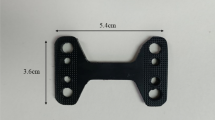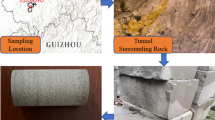Abstract
Considering the effects of seepage and dynamic pressure, defining a rock mass as a saturated porous media, and using the finite element method, a dynamic fluid–structure interaction model of a subsea tunnel with a viscous spring artificial boundary is established. Adopting rubber and foam concrete as shock absorption layers and inputting both horizontal and vertical earthquake waves, the time history curves of the first principal stress at key points in the secondary lining structure are comparatively analyzed based on the presence and absence of shock absorption layers. The principal stress peaks are also analyzed. The damping effect of the shock absorption layer is studied. The results show that the peak and principal stresses at the main parts of the tunnel lining structure decrease after the shock absorption layer is established. Obvious decreases occur in the vault and inverted arch. A certain degree of peak stress reduction is also observed after the shock absorption layer is established. Establishing the shock absorption layer does not change the spectrum characteristics of the tunnel structure. Foam concrete shock absorption is recommended because the damping effect of foam concrete is more observable than that of rubber.







Similar content being viewed by others
References
Cheng XS, Wang JH, Du XL (2013) Fluid-solid coupling based seismic response analysis of subsea tunnels during seepage. Mod Tunn Technol 50(6):44–51
Cheng XS, Ren Y, Du XL, Zhang YD (2014a) Seismic stability of subsea tunnels subjected to seepage. Sci World J 2014:631925. https://doi.org/10.1155/2014/631925
Cheng XS, Xu WW, Yue CQ, Du XL (2014b) Seismic response of fluid-structure interaction of undersea tunnel during bidirectional earthquake. Ocean Eng 75(1):64–70. https://doi.org/10.1016/j.oceaneng.2013.11.017
Cheng XS, Yu DJ, Liu B et al (2016) Stability analysis of cross sea tunnel with shock absorption subjected to seepage and bi-directional earthquake. J Railw Sci Eng 13(5):882–890
Cheng XS, Li D, Ren Y, Du XL (2017a) Seismic stability analysis of subsea tunnels under the effects of seepage and temperature. Mar Georesour Geotechnol 35(6):806–816
Cheng XS, Zhang XY, Chen WJ et al (2017b) Stability analysis of a cross-sea tunnel structure under seepage and a bidirectional earthquake. Int J Geomech 17(9):06017008. https://doi.org/10.1061/(asce)gm.1943-5622.0000937
Cheng XS, Li GL, Chen J et al (2018) Seismic response of a submarine tunnel under the action of a sea wave. Marine structures 60(2018):122–135. https://doi.org/10.1016/j.marstruc.2018.03.004
Gao WL (2001) Study on seismic responses and vibration-absorption measures for extra-long tunnel of the shallow section in high intensity earthquake zone. Ph.D. thesis of Beijing Jiaotong University
Gao L, Chen YH (2008) Analysis of shock absorption measures in tunnels based on ANSYS software. J Shihezi Univ Nat Sci Ed 26(4):495–498. https://doi.org/10.3969/j.issn.1007-7383.2008.04.025
Gao F, Shi YC, Yan SH et al (2005) Study of two shock absorption measures in tunnel. Chin J Rock Mech Eng 24(2):222–229. https://doi.org/10.3321/j.issn:1000-6915.2005.02.007
Hasheminejad SM, Miri AK (2008) Seismic isolation effect of lined circular tunnels with damping treatments. Earthq Eng Eng Vib 7(3):305–319. https://doi.org/10.1007/s11803-008-0842-7
Huang S, Chen WZ, Yang JP et al (2009) Research on earthquake-induced dynamic responses and aseismic measures for underground engineering. Chin J Rock Mech Eng 28(3):483–490. https://doi.org/10.3321/j.issn:1000-6915.2009.03.006
Kim DS, Konagai K (2000) Seismic isolation effect of a tunnel covered with coating material. Tunn Undergr Space Technol 15(4):437–443. https://doi.org/10.1016/s0886-7798(01)00012-8
Konagai KZ, Kim DS (2001) Simple evaluation of the effect of seismic isolation by covering a tunnel with a thin flexible material. Soil Dyn Earthq Eng 21(4):287–295. https://doi.org/10.1016/s0267-7261(01)00012-4
Li YS (2006) Study on earthquake responses and vibration-absorption measures for mountain tunnel. Ph.D. thesis of Tongji University
Ling YT, Gao B (2008) Study on shock absorption measures for double-lane highway tunnels in high earthquake intensity regions. Tunn Constr 28(4):412–415
Liu JY, Chen GY, Jiang W (2010) Study on shock absorption measures of water-conveyance tunnel. J Disaster Prev Mitig Eng 30(2):196–201. https://doi.org/10.3969/j.issn.1672-2132.2010.02.014
Pang C (2017) Study on the dynamic model of soil-pipe-water interaction for buried pipelines under earthquake. Master degree thesis of Southwest Jiaotong University 17
Shimamura SD, Kasai H, Haruumi M (1999) Seismic isolation effect for a tunnel with a soft isolation layer. Earthq Eng 16(2):143–154
Sun TC (2009). Study on earthquake responses and vibration-absorption measures for two-tunnels of mountain tunnel with staggered space. Ph.D. thesis of Southwest Jiaotong University
Tao JH (2005) Numerical simulation of water waves. Tianjin University Press, Tianjin
Wang ZS (2008) Study on seismic dynamic responses and vibration-absorption measures for portal of double-arch tunnel. Ph.D. thesis of Southwest Jiaotong University
Wang MN, Cui GY (2010) Establishment of tunnel damping model and research on damping effect with model test in highly seismic area. Rock Soil Mech 31(6):1884–1890
Wang X, Dong J (2003) Formulation and study of thermal-mechanical coupling of saturated porous media. Int J Comput Struct 81(8–11):1019–1029. https://doi.org/10.1016/s0045-7949(02)00476-5
Wang ZJ, Gao B, Guan BS (1996) Research of isolation of rock-liner structure systems. J Southwest Jiaotong Univ 31(6):590–594
Xie KH, Zhou J (2002) The finite element analysis theory and application in geotechnical engineering. Science Press, Beijing
Xiong LX, Li TB, Yang LD (2007) Numerical analysis of two-shock absorption measures of tunnel. Hydrogeol Eng Geol 34(4):36–40. https://doi.org/10.3969/j.issn.1000-3665.2007.04.010
Xu TN (2014) Study on nonlinear spectrum of isolated structure and its input energy. Master degree thesis of Lanzhou University of Technology
Yuan S (2008) Seismic response analysis and vibration absorption measure of shallow-depth tunnel. Thesis of Wuhan University of Technology
Acknowledgements
This paper is a part of the national natural science foundation of China (Grant Number: 51478212), and a part of the national key basic research and development plan of China (973 plan; Grant Number: 2011CB013600), and a part of the education ministry doctoral tutor foundation of China (Grant Number: 20136201110003).
Author information
Authors and Affiliations
Corresponding author
Ethics declarations
Conflict of interests
The authors declare that there is no conflict of interests regarding the publication of this paper.
Additional information
Publisher's Note
Springer Nature remains neutral with regard to jurisdictional claims in published maps and institutional affiliations.
Rights and permissions
About this article
Cite this article
Cheng, X., Kang, T., Yue, C. et al. Shock Reduction Techniques for a Submarine Tunnel. Geotech Geol Eng 37, 3781–3804 (2019). https://doi.org/10.1007/s10706-019-00868-3
Received:
Accepted:
Published:
Issue Date:
DOI: https://doi.org/10.1007/s10706-019-00868-3




